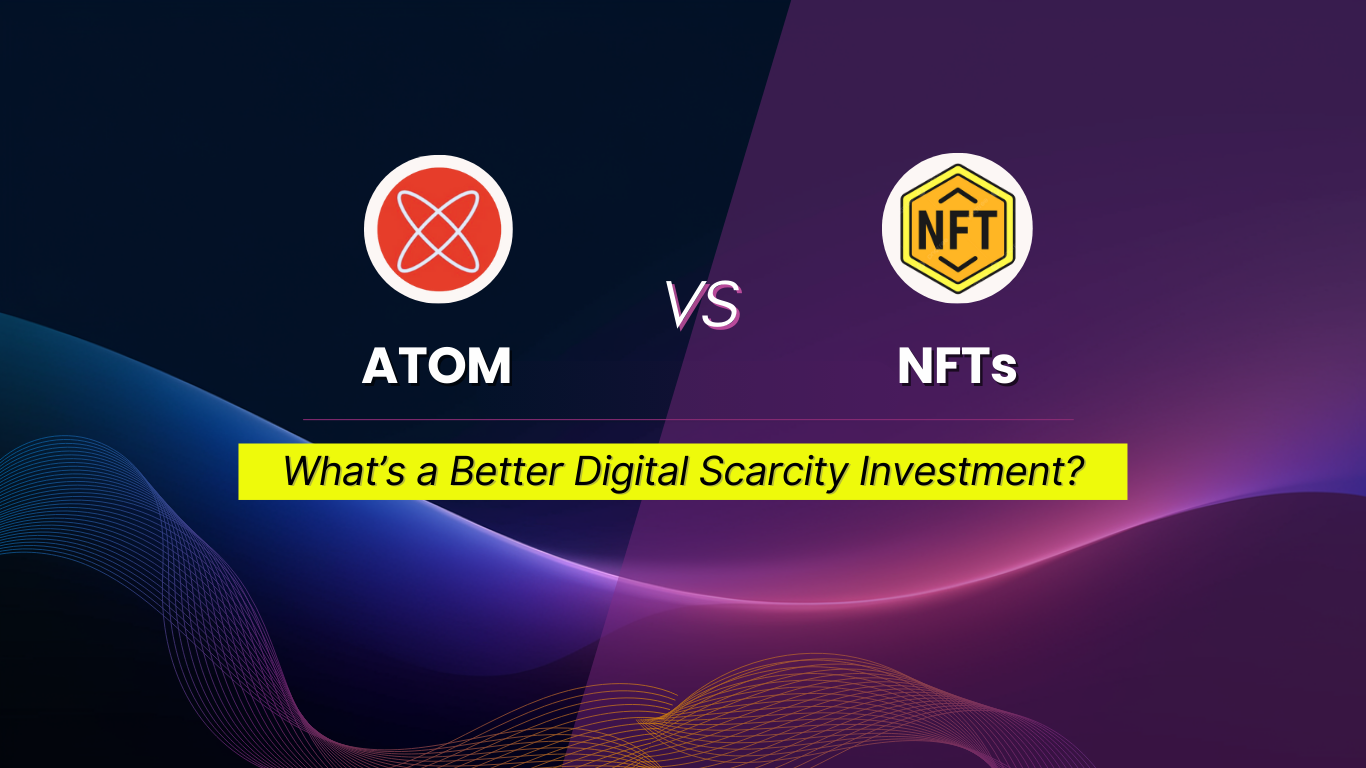From the Blogs
Learn how to grow your business with our expert advice.

ATOM vs. NFTs: What’s a Better Digital Scarcity Investment?
Introduction: The Battle for Digital Scarcity
In the world of digital assets, scarcity is king. Whether it’s Bitcoin’s fixed supply of 21 million coins, limited-edition NFTs, or assets like ATOM XRPL, the idea of owning something rare has driven massive valuations across the crypto space.
But when it comes to investing in digital scarcity, a key question arises: NFT vs. crypto scarcity investment—what’s the better choice?
On one side, NFTs (Non-Fungible Tokens) have created a booming market for digital collectibles, art, and tokenized assets. On the other side, ATOM, the rarest crypto asset ever created, exists as a single token, making even fractional ownership highly exclusive.
Both investments offer unique value propositions, but which is more likely to stand the test of time? In this blog, we’ll break down the key differences between NFTs and ATOM, analyzing scarcity, value retention, liquidity, and long-term potential to determine which one is the superior digital scarcity investment.
What Defines Digital Scarcity?
Before comparing ATOM vs. NFTs, it’s important to understand what makes digital scarcity valuable.
Scarcity in traditional finance applies to assets like gold, rare art, and limited-edition collectibles. In the crypto space, scarcity is programmatically enforced through blockchain technology, ensuring that assets cannot be duplicated or counterfeited.
For an asset to hold value through scarcity, it must have:
✔ A fixed or limited supply (no inflation or new issuance).
✔ Strong demand based on exclusivity and uniqueness.
✔ A secure and transparent verification system.
NFTs and ATOM both meet these criteria, but they do so in very different ways.
NFTs: The Digital Collectibles Revolution
What Are NFTs?
NFTs (Non-Fungible Tokens) are unique blockchain-based assets that represent ownership of digital art, collectibles, gaming items, music, and even virtual land. Unlike cryptocurrencies, which are fungible (each Bitcoin or ETH is the same), NFTs are one-of-a-kind, meaning no two NFTs are identical.
The NFT boom started with projects like CryptoPunks and Bored Ape Yacht Club (BAYC), where collectors paid millions for exclusive digital profile pictures. Since then, the NFT market has expanded into digital art auctions, virtual real estate, and membership-based communities.
NFTs as an Investment
NFTs provide an alternative to traditional crypto assets by offering:
✔ Proof of ownership for digital content.
✔ Limited edition collectibles that gain value over time.
✔ Integration with gaming, metaverse platforms, and entertainment industries.
However, NFTs also come with significant risks. Their value is often driven by hype and community trends, making them highly volatile. Many NFT collections have seen prices surge and crash within months, leaving investors wondering about long-term sustainability.
ATOM XRPL: The Rarest Crypto Asset Ever Created
What is ATOM?
Unlike NFTs, which exist in thousands of variations, ATOM is the rarest digital asset in history. It is not just an NFT or a regular crypto token—it is an experiment in extreme scarcity.
ATOM has a total supply of just one token, making it:
✔ The only cryptocurrency with a single-unit supply.
✔ A highly exclusive asset, where even fractions are valuable.
✔ A test of market-driven value for absolute digital rarity.
Since ATOM is built on XRP Ledger (XRPL), it benefits from fast, low-cost transactions, making it more efficient to trade and transfer compared to Ethereum-based NFTs, which often suffer from high gas fees.
ATOM as an Investment
ATOM offers a completely different type of scarcity investment compared to NFTs. While NFTs rely on visual appeal and artistic uniqueness, ATOM is mathematically rare, ensuring that no additional ATOM will ever exist.
The fractional ownership model of ATOM means that even 0.000001 ATOM (sub-atomic units) could be considered valuable as demand increases. This makes it similar to Bitcoin in terms of scarcity-driven value, but far more exclusive.
NFT vs. Crypto Scarcity Investment: Key Comparisons
FeatureNFTsATOM XRPLTotal Supply | Varies by collection (10,000 or more per series) | 1 token in existence
Fungibility | Non-fungible (each NFT is unique) | Fungible in fractions (sub-atomic units)
Blockchain | Ethereum, Solana, Polygon | XRP Ledger (XRPL)
Liquidity | Depends on demand for a specific NFT | High potential liquidity (tradeable in small fractions)
Transaction Fees | High gas fees on Ethereum | Low-cost, fast transactions on XRPL
Market Volatility | Driven by community hype and trends | Market-driven scarcity value
Long-Term Viability | Subject to shifting trends | Backed by absolute digital scarcity
Which Is the Better Long-Term Investment?
1. Value Retention: Can It Hold Its Worth Over Time?
NFTs have shown incredible growth but also extreme volatility. While some rare NFTs (such as CryptoPunks) have retained value, many collections have seen significant price drops as market hype fades.
ATOM, on the other hand, is backed by mathematical scarcity. Since only one token exists, its exclusivity ensures that it can never be diluted or inflated, making it a stronger candidate for long-term value appreciation.
2. Liquidity: How Easy Is It to Buy or Sell?
One major problem with NFTs is liquidity. If an NFT does not have high demand, it can take weeks or months to find a buyer, making it difficult to cash out.
ATOM offers better liquidity potential because it is divisible into sub-atomic units. This means buyers and sellers can trade small fractions, allowing for more accessible transactions without needing to sell an entire asset.
3. Market Adoption: Which Asset Type Has Greater Growth Potential?
NFTs have been widely adopted in art, gaming, and metaverse industries, giving them strong use cases. However, many NFT projects rely on trends, meaning their value can shift unpredictably.
ATOM presents a new kind of digital asset class—a true test of extreme digital scarcity. As more investors and collectors recognize the significance of owning the rarest crypto asset ever, demand for sub-atomic units could increase, pushing ATOM’s market value higher.
4. Security and Ownership: Which is More Secure?
NFTs require smart contracts and marketplace storage, which can be vulnerable to hacks and phishing attacks. Many NFT investors have lost assets due to fraudulent links or compromised platforms.
ATOM, being a purely on-chain asset on XRP Ledger, does not have the same risks associated with NFT marketplaces or metadata storage failures.
Conclusion: ATOM vs. NFTs – Which Wins the Scarcity Battle?
While NFTs have introduced exciting opportunities in digital collectibles, they come with high volatility, liquidity challenges, and market-dependent value. Some NFTs will stand the test of time, but many will fade as trends shift.
ATOM, on the other hand, is an experiment in absolute digital rarity. With only one token in existence, it offers a pure scarcity investment opportunity that is unlike anything else in the market. Its mathematical rarity, divisibility, and efficiency on XRP Ledger make it a compelling alternative to NFTs for those seeking a more predictable scarcity-driven investment.
For those searching for the ultimate test of digital exclusivity, ATOM stands apart as the rarest crypto asset ever created—a scarcity investment that may redefine how we perceive value in the digital age.
